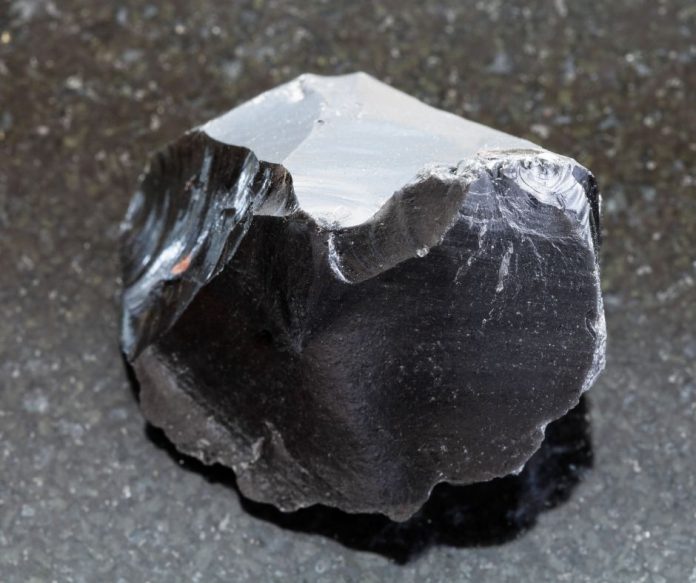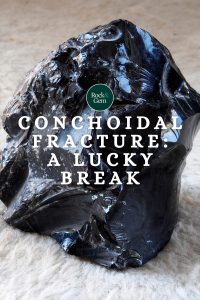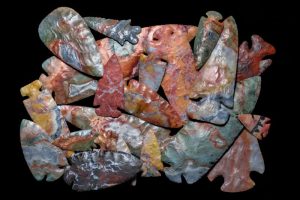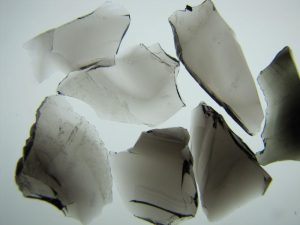
Conchoidal fracture was once described by an anthropologist as the first big step in human technological development — a “lucky break.” She was referring to the serendipitous discovery some 2.5 million years ago that certain high-silica stone materials would fracture conchoidally and could be broken, or flaked, into sharply edged and pointed tools and weapons. Controlled, systematic conchoidal fracturing, a skill originated by Paleolithic stoneworkers, is still practiced by flint knappers today.

Fracture is not to be confused with mineral cleavage, which refers to separation along regular, internal crystal planes. Fracture is, instead, the irregular breakage of rocks and minerals. All fine-grained, brittle rocks and minerals, such as flint, will fracture when struck with a hard object. Various types of fracture include uneven, hackly, splintery, irregular, and conchoidal.
Conchoidal Fracturing
Conchoidal fracturing produces smoothly curved, concave surfaces similar in appearance to the inner surfaces of bivalve mollusk shells. The word “conchoidal” comes from the Greek konchoeidēs, meaning “like a mussel.”
Conchoidal fracture occurs mainly in crystalline rocks and minerals with poor cleavage; it is also seen in certain homogenous noncrystalline materials. Visually distinctive conchoidal fractures are a readily recognizable, diagnostic feature of certain minerals, notably quartz and its microcrystalline varieties.
Mechanics of Conchoidal Fracture

Wade Wilcox
Conchoidal fracturing begins at impact and is accompanied by primary and secondary shock waves of energy that radiate through the material. The direction of fracture is controlled by the direction of impact.
When a knapper strikes a piece of flint, shock waves progress at an angle slightly declined from the surface. Instantaneous fracturing absorbs part of the shock wave energy. As this energy decreases, the shock waves steer the rapidly progressing fracture in the direction of least resistance, in other words, back toward the surface of the flint. An impact of the proper energy, duration and direction simultaneously displaces a separated flake and leaves a conchoidal depression in the surface of the flint.
Conchoidal depressions are often marked with concentric, curvilinear ridges called “Wallner lines” that are perpendicular to the direction of fracture progression. Formed by the interaction of primary and secondary shock waves, they appear much like the growth rings seen in many seashells.

Steve Voynick
Obsidian and Pyrite
Many knappers consider obsidian the ultimate flaking material. A volcanic glass, obsidian is a brittle, homogenous, noncrystalline mineraloid with a pronounced conchoidal fracture. Its most extraordinary property is the thinness and sharpness of its conchoidal flakes. Flaked obsidian has been utilized in everything from Aztec sacrificial knives to modern scalpels that are even sharper than surgical-steel blades.
Unlike obsidian, pyrite has a subconchoidal fracture, meaning it exhibits both irregular and conchoidal fracture characteristics. However, its tendency to fracture conchoidally is not predictable enough to flake pyrite into utilitarian shapes.
Gem Materials
Conchoidal fracturing can be a problem in certain gems. Opal, a non-crystalline, high-silica mineraloid that is compositionally similar to obsidian, is brittle and chips easily to form conchoidal fractures.
Peridot, despite its well-developed cleavage planes, is another gem that fractures conchoidally. Most transparent, colored gems are susceptible to conchoidal fracturing, which most often appears as chipping around the girdle of the gems.
Amber exhibits a pronounced conchoidal fracture and is most likely to chip in cold temperatures. Like amber, jet, a gem form of black, compact lignite coal, is also susceptible to cold-temperature conchoidal fracturing.

Wikimedia Commons
Rocks
Even very fine-grained rocks, such as rhyolite, a silica-rich, extrusive volcanic rock, and quartzite, a metamorphosed sandstone, can fracture conchoidally.
Although the points and edges of flaked rhyolite and quartzite are not nearly as sharp as those of flint or obsidian, Paleolithic stoneworkers nevertheless used both extensively. Because of their abundance, they were vital to the production of tools and weapons, especially in regions where flint or obsidian was scarce. But lacking the eye-catching, glassy fracture surfaces of flint and obsidian, rhyolite and quartzite are rarely used today as knapping mediums.
Conchoidal fracture is usually thought of as the dozens or even hundreds of tiny concave depressions on the surfaces of flaked stone weapons and tools. But these fractures can sometimes be enormous. An example is the 60-foot-wide conchoidal depression in a silicified sandstone cliff at Utah’s Arches National Park that is believed to have formed from the impact of a large, falling boulder.
Conchoidal Fracture In Archeology
Because conchoidal fractures form only by mechanical means and never by “frost-cracking” or other tresses, they enable archaeologists to differentiate stone artifacts from similarly appearing, natural objects.
Obsidian’s unusual weathering properties help archaeologists to date flaked artifacts. After flaking, the newly exposed obsidian surfaces slowly hydrate and alter into perlite, building a thin hydration rind that can be accurately measured. Independent of climatological conditions, hydration-rind thickness directly indicates the age of flaked obsidian artifacts.
Flaked stone, once so vital to human survival and the most durable and abundant of all Stone Age artifacts, tells the story of early human development and knapping survives today as an art form. Flaking stone has quite a legacy, all of it because of our ability to exploit conchoidal fracturing, a skill that began, as that anthropologist so astutely said, with a “lucky break.”
This story about conchoidal fracture appeared in Rock & Gem magazine. Click here to subscribe. Story by Steve Voynick.












